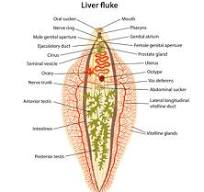Lung Fluke- Paragonimus westermani
PKGhatak, MD
Humans are infected by Paragonimus westermani from eating uncooked or poorly cooked crab, crayfish and pork. Metacercariae stage of the parasite travel from the intestine to reach the lungs through the diaphragm. And within a month of reaching the lungs, the worms reach maturity and a pair of adults cross fertilize each other and begin laying eggs in the bronchus. The eggs are coughed up and spat out or swallowed. Eggs hatch in water, and newly released miracidia seek out snails. Within the muscles of the snails, the parasites multiply and develop into a motile form of cercariae. Cercariae leave the snail. Circariae moves along the bottom of rivers or lakes and finds the 2nd intermediate hosts – crabs, shrimps and crayfish. Again, the parasites multiply and develop into infective metacercariae and are ready to infect humans or any mammals of the cat family.
In East Asia, lung fluke infections are mostly seen, however, the lung fluke infection is prevalent in a wide area of the world, wherever the people eat raw crab meat, or pickled crab and shrimps, and raw crayfish. It is estimated that 200 million people are at risk of lung fluke infection.
Symptoms and diseases produced by paragonimus parasites:
Following ingestion, the eggs hatch in the intestine and migrate to the lungs. For 2 days to 2 weeks, during migration of the parasites, the patients have symptoms of abdominal pain and diarrhea. These symptoms are followed by fever, chest pain, cough, rusty sputum production, blood eosinophilia and various forms of infiltrates in the lungs detected by chest x-rays. Occasionally, pneumothorax and a small pleural effusion develop.
Weeks later, the main symptoms become chronic cough, with a low grade fever, fatigue and sputum containing traces of blood, resembling pulmonary tuberculosis and or chronic bronchitis with bacterial infection.
In heavy parasite infection, in 25% of hospitalized patients, the parasites move into the cranial cavity and produce symptoms of meningitis and meningoencephalitis, and seizures. Occipital and temporal lobes are commonly infected. Diplopia to blindness develops. Characteristic soap bubble like pictures are seen within the lateral and occipital ventricles of the brain on CT or MRI of the brain. The CSF examination shows high eosinophil counts.
Diagnosis.
Sputum examination detected P. westermani eggs, each one measures 80 -120 x 4 – 6 micrometers, and are diagnostic. Specific IgM and IgG ELISA tests are also used, specially in CNS infections.
Treatment:
Praziqyental orally for 3 days is quite effective.
Anatomy of P.westermani:
The four stages of the parasite are as follows: Eggs, Cercaria, Metacercaria and adult worm.
Eggs – An egg is 80 -120 x 40-60 micro M, brown in color, and resembles a coffee bean.
Cercaria and Metacercaria are similar in size and appearance to any other Trematode worm,Adult – the adult worm is 7 -12 mm long and 4 -6 mm wide. The outer wall is covered with scales like spines. It has two suckers like any other Trematodes, and each one has both the male and female sex organs. But unlike Liver flukes, Lung flukes meet as a pair and cross-fertilize each other. Adult worms produce fibrous cavities in the bronchi filled with their excreta and altered blood

Life Cycle of P. westermani.
In general, P. westermani needs a snail as an intermediate host, but unlike the liver fluke P. westermani, it requires another host – crabs and crayfish for the multiplication and development to an infective form. P. westermani uses any locally available snail species, unlike liver flukes.
************************************************************
.


